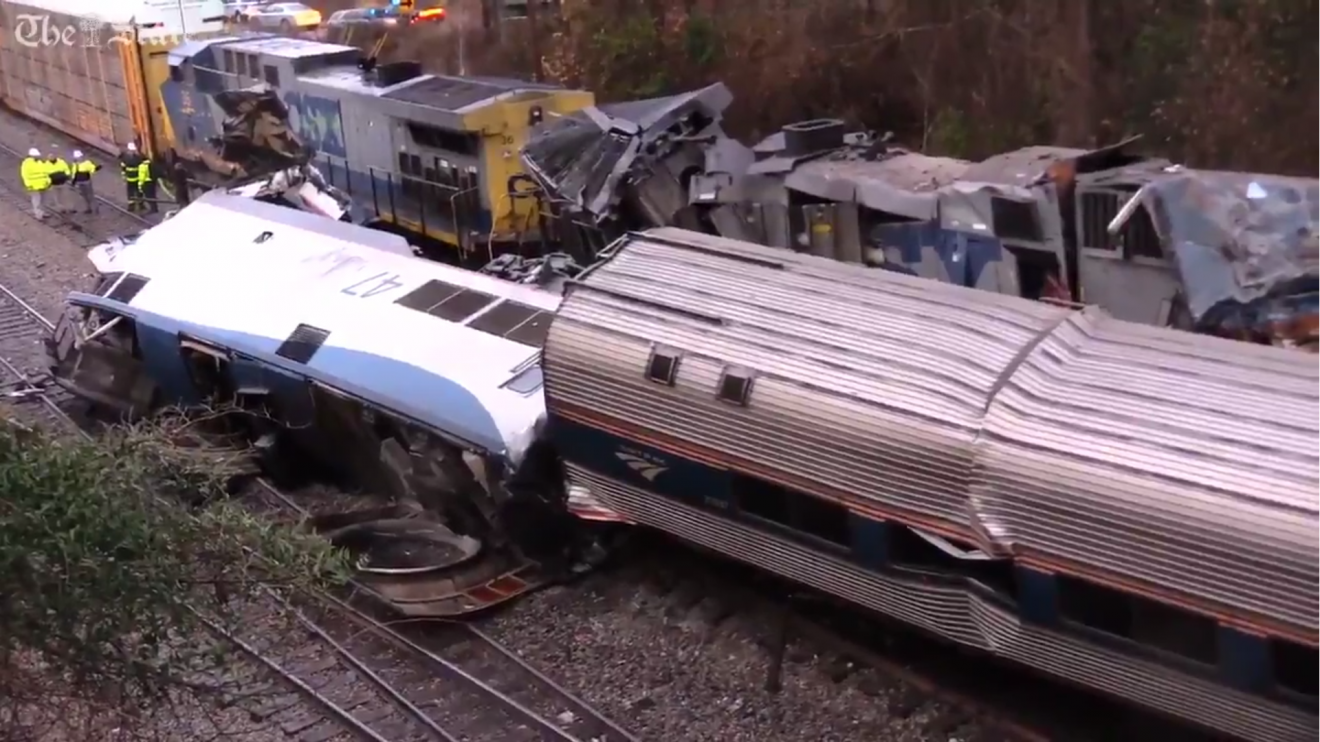Two people were killed around 2:34 a.m. on February 4 when Amtrak’s Silver Star (train 91) from New York to Miami “came in contact with” a CSX freight train in Cayce, South Carolina in what appears to have been a head-on collision. Seven passengers were taken to local hospitals, and approximately 116 others were injured with anything from minor cuts to broken bones, according to Lexington County and South Carolina emergency management officials.
South Carolina Governor Henry McMaster confirmed on Sunday that the two killed in the accident were both Amtrak employees – 54-year-old train engineer Michael Kempf, and 36-year-old conductor Michael Cella. He described the lead CSX engine as having been “torn up” and said that the Amtrak engine was “barely recognizable.”
NTSB Chairman Robert Sumwalt at an afternoon press briefing on Sunday provided preliminary details of the collision. The Amtrak train’s forward video camera has been recovered, but the Event Data Recorders haven’t yet, partially due to the state of the two locomotives which Sumwalt said had suffered “catastrophic damage.” The maximum authorized track speed in the area is 59 miles per hour, according to Sumwalt.
The CSX train in the track siding where the collision happened had previously unloaded four “autorack” cars loaded with vehicles at a nearby facility, and was backed into the siding. The switch controlling whether trains run straight or enter the siding was “lined and locked” in position with a padlock to ensure that the switch wouldn’t move when the CSX train passed over it. But that padlock forcing trains into the siding was apparently still in place when the Amtrak train next passed, causing it too to enter the siding and collide with the CSX train.
The use of a padlock is standard operating procedure for manual operation of the track switch, but it should have been removed after the CSX train was safely parked in the siding.
The key question, Sumwalt said, is to figure out why the switch was still set to route trains into the siding when it was already occupied. The NTSB hopes to interview the crew of the CSX train in the near future.
In a memo sent to employees, Amtrak CEO Richard Anderson said that train 91 “was cleared to proceed by CSX dispatch, but CSX had lined and padlocked the switch off the mainline to the siding, causing the collision.”
NTSB on scene of South Carolina Amtrak-CSX train collision. pic.twitter.com/oubbUFg28J
— NTSB_Newsroom (@NTSB_Newsroom) February 4, 2018
A statement on Amtrak’s website says there were eight crew and approximately 139 passengers onboard. The lead engine and at least two passenger cars in the train derailed. The statement notes “We are deeply saddened to report the death of two of our employees in this morning’s derailment in Cayce, South Carolina.”
CSX controls the tracks and routes trains in the area where the Amtrak train was running.
“We are cooperating fully with the NTSB, which is leading the investigation, as well as working with FRA and CSX. CSX owns and controls the Columbia Subdivision where the accident occurred. CSX maintains all of the tracks and signal systems. CSX controls the dispatching of all trains, including directing the signal systems which control the access to sidings and yards.”
Amtrak incident response statement
The Jacksonville Business Journal reported Sunday morning that CSX signal crews had been working in the area where the crash happened, and that the signaling system which would have warned about a switch being misaligned may have been deactivated, allowing the collision to occur.
An Amtrak #train crashed in Cayce, #SC killing two and injuring dozens. pic.twitter.com/5ahOQuNNUJ
— The State Newspaper (@thestate) February 4, 2018
Analysis of The State Newspaper’s video appears to show that both the CSX and Amtrak train were on the same siding track which diverged off of the center track (as seen in the video) not too far away from the derailment. The siding, which can be used to allow one train to pass another, is approximately one mile long (1.5km), and merges back in with the same center track to the southwest of the collision location.
South Carolina’s governor reported that the CSX freight train was stationary at the time of collision.
A transportation safety director with South Carolina’s Office of Regulatory Staff told The State that the cause of the collision “was probably a switching issue” which led to both trains to be on the same track. The exact nature of the issue will be determined by the NTSB, but both mechanical failures and human error will be investigated.
It is unclear why both trains were on the same track at the same time, and why the switch may have been leading the Amtrak train to the siding track and not keeping it on the main line.

Lexington County officials also responded to two fuel leaks caused by the collision which spilled approximately 5,000 gallons. The county’s and CSX’s hazmat teams were dispatched and are dealing with that as well.







